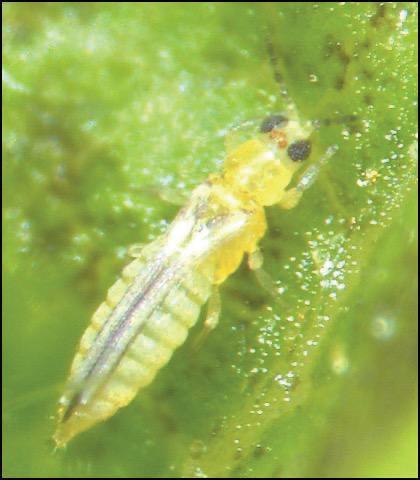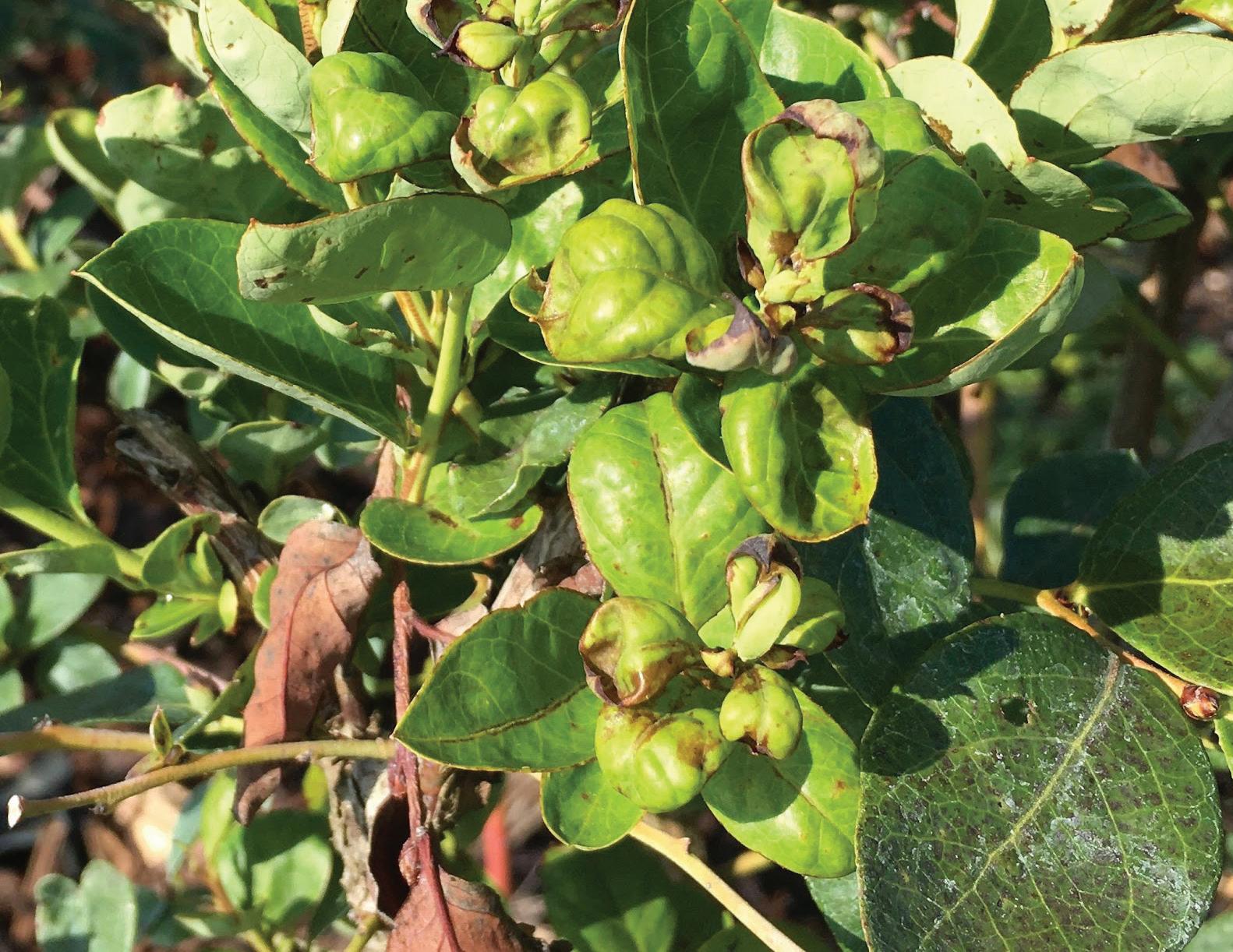
5 minute read
TOP THREAT
Figure 1. Adult chilli thrips. Photo by B. Panthi, UF
Tips to Help Mitigate Damage From Chilli Thrips
Advertisement
Chilli thrips are a significant pest on southern highbush blueberries in Florida with the potential to cause heavy foliage damage from late spring through early fall. Although there are insecticides with efficacy on chilli thrips, the numbers of applications used and cost of products have become a significant management issue for Florida growers.
“Chilli thrips have emerged as the number one pest threat at Frogmore Fresh,” says Leonard Park, president of the Florida Blueberry Growers Association and farm manager at Frogmore Fresh.
“We start seeing them in spring as soon as young suckers flush and they crank up before we finish harvest in May. Once we hedge, they explode in June if we haven’t already geared up our protection program. We continue fighting them into September, always diligent to scout and respond. Suppression seems the best we can achieve. Some go-to chemicals like Delegate are now losing effectiveness, so we have tried numerous alternatives with no satisfactory solution. As the most costly pest for our farm, we hope our UF experts and the crop protection industry can find new and better options.” The following is a discussion of this insect pest, along with management suggestions and the results of recent insecticide field trials.
Chilli thrips, (Scirtothrips dorsalis Hood), were first observed in Florida in 1991 and again in 1994, with the first established population reported in October 2005 on roses in Palm Beach County. It was first recorded in blueberries in Hernando, Pasco, and Sumter counties in July 2008. Chilli thrips typically appear during the new flush of foliage growth following post-harvest hedging in late spring to early summer, and prefer feeding on young, tender foliage.
Adult chilli thrips are only 1-2 mm (<1/16 inch) in length, smaller than flower thrips, with pale yellow bodies, dark fringed wings, and dark brown incomplete abdominal stripes (Figure 1). The lifecycle of chilli thrips (i.e., egg, larva, pupa, and adult) is short and typically lasts about 18-20 days in favorable environmental conditions. Adult females lay about 60 eggs in their lifetime. Eggs usually hatch in 5-8 days, depending on environmental conditions. There are two larval stages that take approximately 8-10 days to develop, during which they are actively feeding. Pupal stages last for 2-4 days when no feeding occurs. Adults emerging from the pupal stages typically live for 20-25 days.
Plant Injury
Chilli thrips feeding can cause substantial damage to blueberry foliage. Adults and larvae punch holes through epidermis cells and remove the cellular contents of leaf and stem tissues, leading to tissue necrosis and death. Injury symptoms first appear as bronzing along leaf veins and petioles, and leaves gradually begin to curl and distort (Figure 2). Heavy infestations can cause leaf defoliation with extensive curling of leaves, reducing photosynthesis and possibly impacting floral bud initiation in cases of significant defoliation. During high infestations chilli thrips may also feed on fruit, causing a mottled appearance.

Figure 2. Chilli thrips feeding injury. Photo by B. Panthi, UF
Monitoring to ensure early detection is important for effective chilli thrips control. Scouting for adults can be performed by observing young leaves with a hand lens (20X), tapping young foliage onto a white sheet of paper or phone screen, or using white or yellow sticky cards.
Chilli thrips can have an irregular distribution within a field with areas of hot spots, so sufficient samples should be collected to provide an accurate estimate of any population in the field. The appearance of bronzing on new flush may be the first indication of the chilli thrips presence in blueberry fields, although at that point there may be significant populations already present.
An integrated pest management (IPM) plan for chilli thrips control includes cultural, biological, and insecticide controls. Cultural control involves the elimination of weeds and other host plants in and around production fields that can support chilli thrips growth and development. Biological controls include beneficial predators such as Orius insidiosus (minute pirate bug), which feeds on all life stages of thrips, as well as Amblyseius swirskii (predatory mites) and Geocoris spp. (big-eyed bugs), which have shown some effectiveness in controlling chilli thrips.
Application of insecticides is the primary method of managing chilli thrips in blueberry. These include spinetoram (Delegate®), tolfenpyrad (Apta®), novaluron (Rimon®), acetamiprid (Assail®), and flupyradifurone (Sivanto®). Spinosad (Entrust®) can be used in organic production. In a recent field trial, spinetoram and tolfenpyrad were the most effective of the insecticides evaluated. Spinetoram has systemic activity, allowing the chemical to be absorbed into plant tissues relatively quickly. Spinetoram has been shown to be effective in controlling all of the life stages of chilli thrips, including egg when mixed with novaluron, an insect growth regulator which affects egg development. The University of Florida plans to conduct additional field trials this summer, and several new products will be evaluated. A list of products registered for managing chilli thrips in Florida blueberries along with their active ingredients and insecticide classes are provided in Table 1. Be sure to follow all insecticide label instructions.
For additional details see UF EDIS Publications ENY-2053, Chilli Thrips on Blueberries in Florida (https://edis.ifas.ufl. edu/pdf/IN/IN129800.pdf) and HS1156, 2022 Florida Blueberry Integrated Pest Management Guide https://edis.ifas.ufl. edu/publication/HS380
DR. OSCAR LIBURD, Professor and Program Leader, Fruit and Vegetable Entomology, UF & DOUG PHILLIPS, UF/IFAS Blueberry Extension Coordinator


